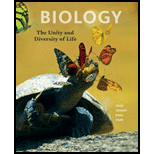
Organic molecules consist mainly of ______ atoms.
- a. carbon
- b. carbon and oxygen
- c. carbon and hydrogen
- d. carbon and nitrogen
Introduction: The molecules that are majorly composed of carbon and hydrogen are classified by chemists as organic molecules. The basis of life is the organic compounds that make it up. Organic chemistry is the study of these compounds. The methodology of synthesis of these compounds is called as organic synthesis.
Answer to Problem 1SQ
Correct answer: The organic compounds are those that consist majorly of carbon and hydrogen atoms. Hence, the correct answer is option c.
Explanation of Solution
Reason for correct answer:
The living organisms are composed of several molecules. They are called as molecules of life. The molecules of life include carbohydrates, fats, proteins, nucleic acids, and many more. They are made of organic molecules, which mainly consist majorly of carbon and hydrogen atoms. The organic molecules also have oxygen, nitrogen, sulphur, and phosphorus atoms in a minor form. These organic molecules are also found in the non-living things.
Option c. is given as “carbon and hydrogen”.
The organic compounds consist mainly of both carbon and hydrogen atoms that are present in different proportions to form various functional groups.
Hence the correct answer is option c.
Reason for incorrect answer:
Option a. is given as “carbon”.
Though the carbon atoms majorly constitute the organic compounds, chemists define organic compounds as those with both carbon and hydrogen atoms. Hence, option a. is incorrect.
Option b. is given as “carbon and oxygen”.
Certain organic molecules like carboxylic acids, carbonyl functions groups, aldehyde groups, and ketone groups contain both carbon and oxygen atoms; oxygen is present in lesser amount than hydrogen. Hence, option b. is incorrect.
Option d. is given as “carbon and nitrogen”.
Certain organic molecules like amino acids, nucleic acids, phospholipids, amides, amines, nitrile, and imine functional groups. Hence, option d. is incorrect.
Hence the options a., b., and d are incorrect.
Want to see more full solutions like this?
Chapter 3 Solutions
Biology: The Unity and Diversity of Life (MindTap Course List)
Additional Science Textbook Solutions
Anatomy & Physiology (6th Edition)
Campbell Biology (10th Edition)
Study Guide for Campbell Biology
Biological Science (6th Edition)
Concepts of Biology
Biology: Life on Earth (11th Edition)
- The building blocks of nucleic acids are _____. Select one: a. nucleotides b. amino acids c. fatty acids d. monosaccharidesarrow_forwardMolecules that are found in living cells and contain the element___________ are considered organic molecules.a. hydrogenb. carbonc. oxygend. nitrogene. calciumarrow_forwardWhen hydrogen is a part of a ________, it has a slight positive charge. a. Ionic bond b. polar covalent bond c. nonpolar covalent bondarrow_forward
- One of the most important properties of water is that it can form a _______ with other water molecules. This means that water molecules are able to “stick together” to a certain extent. The term for this property is cohesion. A. Ionic bond B. Covalent Bond C. Hydrogen Bondarrow_forwardThe backbone of all organic molecules is:a. oxygenb. sulfurc. nitrogend. carbone. phosphorusarrow_forwardOrganic molecules consist mainly of atoms.a. carbon c. carbon and hydrogenb. carbon and oxygen d. carbon and nitrogenarrow_forward
- In general, oils generally have _____. Select one: a. a high degree of unsaturated bonds b. long fatty acid chains c. a high water content d. a high degree of saturated bondsarrow_forwardThe smallest unit of any substance is the . a. atom b. molecule c. cellarrow_forwardA molecule of ammonia contains one atom of nitrogenand three atoms of hydrogen. These are linked with ________.a. ionic bondsb. nonpolar covalent bonds c. polar covalent bondsd. hydrogen bondsarrow_forward
- The mutual attraction of opposite charges holds atomstogether as molecules in a(n) ________ bond.a. ionic c. polar covalentb. hydrogen d. nonpolar covalentarrow_forwardEach carbon atom can bond with as many as-_________ other atom(s). a. one c. three b. two d. fourarrow_forwardThe tertiary structure of many proteins reveals that nonpolar portions are primarily on the ________ of the molecule a. interior b. exteriorarrow_forward
 Human Anatomy & Physiology (11th Edition)BiologyISBN:9780134580999Author:Elaine N. Marieb, Katja N. HoehnPublisher:PEARSON
Human Anatomy & Physiology (11th Edition)BiologyISBN:9780134580999Author:Elaine N. Marieb, Katja N. HoehnPublisher:PEARSON Biology 2eBiologyISBN:9781947172517Author:Matthew Douglas, Jung Choi, Mary Ann ClarkPublisher:OpenStax
Biology 2eBiologyISBN:9781947172517Author:Matthew Douglas, Jung Choi, Mary Ann ClarkPublisher:OpenStax Anatomy & PhysiologyBiologyISBN:9781259398629Author:McKinley, Michael P., O'loughlin, Valerie Dean, Bidle, Theresa StouterPublisher:Mcgraw Hill Education,
Anatomy & PhysiologyBiologyISBN:9781259398629Author:McKinley, Michael P., O'loughlin, Valerie Dean, Bidle, Theresa StouterPublisher:Mcgraw Hill Education, Molecular Biology of the Cell (Sixth Edition)BiologyISBN:9780815344322Author:Bruce Alberts, Alexander D. Johnson, Julian Lewis, David Morgan, Martin Raff, Keith Roberts, Peter WalterPublisher:W. W. Norton & Company
Molecular Biology of the Cell (Sixth Edition)BiologyISBN:9780815344322Author:Bruce Alberts, Alexander D. Johnson, Julian Lewis, David Morgan, Martin Raff, Keith Roberts, Peter WalterPublisher:W. W. Norton & Company Laboratory Manual For Human Anatomy & PhysiologyBiologyISBN:9781260159363Author:Martin, Terry R., Prentice-craver, CynthiaPublisher:McGraw-Hill Publishing Co.
Laboratory Manual For Human Anatomy & PhysiologyBiologyISBN:9781260159363Author:Martin, Terry R., Prentice-craver, CynthiaPublisher:McGraw-Hill Publishing Co. Inquiry Into Life (16th Edition)BiologyISBN:9781260231700Author:Sylvia S. Mader, Michael WindelspechtPublisher:McGraw Hill Education
Inquiry Into Life (16th Edition)BiologyISBN:9781260231700Author:Sylvia S. Mader, Michael WindelspechtPublisher:McGraw Hill Education





